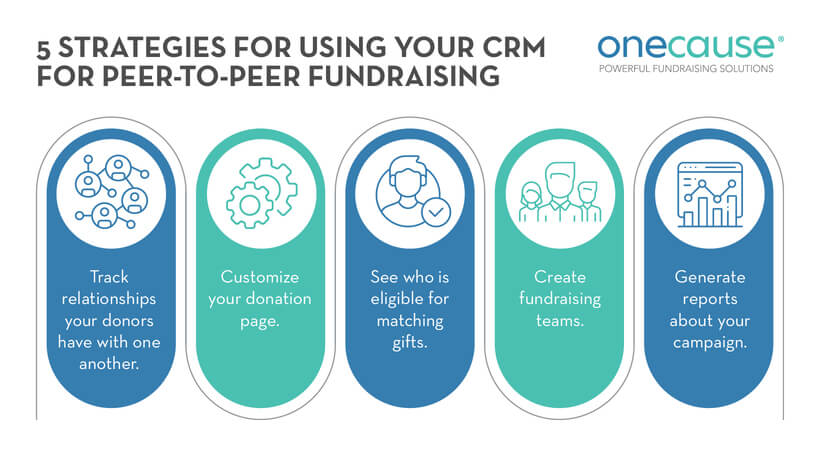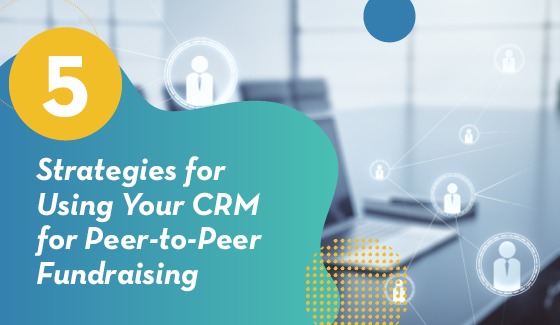This guest author post was contributed by OneCause.
Keeping track of your donors is essential for any nonprofit. Donors help keep your nonprofit running, so you should always aim to keep them in the know and provide as much of a personalized experience as you can.
This is especially true of your donors who launch their own peer-to-peer fundraising campaigns. These leaders help spread the word about your organization and raise funds for your cause by leveraging their relationships and social networks. In fact, according to the OneCause study on The Giving Experience, 49% of social donors (engaged or acquired through peer-to-peer fundraising) said they contributed to a cause because they cared about the person who asked them to. That’s a powerful giving motivator!
For this reason, you should help your fundraisers, whether it’s by providing helpful resources for fundraising or avoiding pain points when filling out forms.
And you might already have the tools you need to help.
Did you know that your CRM can drastically improve your peer-to-peer fundraising campaigns? You’re likely already using your CRM to manage your donor relationships and other important information, all of which is helpful for a peer-to-peer campaign. By using your CRM to support your peer-to-peer fundraising efforts, you can:
- Track relationships your donors have with one another.
- Customize your donation page.
- See who is eligible for matching gifts.
- Create fundraising teams.
- Generate reports about your campaign.
With such a powerful tool at your fingertips, it makes sense to use its full capabilities to support all types of fundraising. With the huge benefits of peer-to-peer fundraising, ensuring your CRM pulls its weight is a no-brainer. Let’s dive in.
1. Track relationships your donors have with one another.
Peer-to-peer fundraising is all about relationships. If a fundraiser has a large network, they will reach more people and have the potential to obtain more donations. For this reason, one of the best practices for peer-to-peer fundraising is to recruit your fundraisers carefully. Your ideal candidates should be individuals who have a history of involvement with your organization and a wide network, whether on social media, in the business world, or in your community.
But how do you determine which fundraisers have strong relationships and connections? Your CRM can help you track relationships between donors, which can give you a better understanding of how your community works together.
For example, perhaps one of your donors is in a leadership position at a company where many other supporters work. With this information, you could recruit this leader for a peer-to-peer fundraising campaign knowing that they will already have many supporting connections at their workplace.
Here are some other benefits of tracking the relationships between your donors:
- Store information about new donors: Once your peer-to-peer campaign gets up and running, track when new donors contribute to your campaign and automatically add their information to your CRM. Plus, be sure to make a record of who informed them about your cause.
- See which networks are related: Tracking your donor relationships gives you great insights into overlap within your donor community, which is helpful for recruiting peer-to-peer leaders, segmenting your donors, and getting to know your contributors better.
- Create teams: With a better understanding of the relationships between your donors, you can encourage friends or family to team up (but more on peer-to-peer fundraising teams later!).
If you’ve never run a peer-to-peer fundraising campaign before and don’t have this information on your donors’ networks yet, don’t worry! Once you get started with your campaign, you’ll learn more about how your donor base is connected and can make smarter decisions in the future. For now, focus on recording all of the relevant information in your nonprofit’s CRM so you can use it later on.
2. Customize your donation page.
Maintaining donor engagement is essential for a successful peer-to-peer fundraising campaign. Sustaining digital engagement is especially important if you’re running your campaign solely online since you do not have an in-person touchpoint to remind everyone about your cause.
One great way to maintain engagement is by using customizable peer-to-peer fundraising software and personalized giving pages. Customization creates a more personal and memorable experience for your donors, which keeps them involved after they’ve donated.
Additionally, customization options provide the opportunity for you to gather more data about your donors. By customizing your peer-to-peer donation forms, you can ask additional questions that might be valuable for your future fundraising efforts. For example, you could ask how a donor learned about your organization, what prompted them to donate, or other questions that would help you inform your fundraising strategy.
For this reason, it’s essential that you integrate your CRM with your peer-to-peer fundraising platform. Your peer-to-peer fundraising campaign will generate a lot of useful data about your donors, so seamlessly transferring that data to your CRM ensures you put the information you’ve gathered to good use.
3. See who is eligible for matching gifts.
Peer-to-peer fundraising presents all kinds of opportunities to raise more and build meaningful relationships, especially through programs like matching gifts. According to this 360MatchPro resource on matching gifts, an estimated $4-$7 billion in matching gift funds go unclaimed every year. That’s a huge missed opportunity!
By using your CRM in your peer-to-peer fundraising campaign, you can avoid losing out on matching gift funds. With the donor data in your CRM and your matching gift software, you can see where your donors work and then determine if their contribution is eligible for matching gifts.
Each company has its own workplace giving guidelines, but with a matching gift database, you can easily find information on a company’s:
- Match ratio. Companies typically match employee donations at a 1:1 rate. For example, if a donor contributes $50, their employer will also donate $50 to your cause. However, companies may match donations at a ratio as low as 0.5:1 and as high as 2:1 or even 3:1.
- Employee eligibility. Many companies will delineate matching gift eligibility guidelines for three different employee types: full-time, part-time, and retired. You may even find that certain businesses match donations made by their employees’ spouses, in which case, you’d want to notify the donor of this opportunity.
- Nonprofit eligibility. If a company feels passionate about certain causes, they may limit matching gifts to nonprofits that align with their program goals. Additionally, companies may require that nonprofits have 501(c)(3) status or may exclude certain organization types, such as religious groups or schools.
- Request deadline. It’s important that your donors know the deadline for submitting their matching gift requests. Some companies set their deadline as the end of the calendar year or one year after donation while others choose a date in March or April to account for holiday season giving.
Not only do matching gifts increase your revenue, but they can also grow your network and make your donors feel like they have made a bigger contribution.
For example, let’s say an employee of a local business contributes to your organization without knowing their employer will match the gift. Using your software, you notify the donor that their employer matches charitable contributions. You’ll effectively double your donation and inform additional people (in this case, the employer) about your organization’s cause, which might lead to even more donations. And with the new connections you’ve made through peer-to-peer fundraising, you can leverage even more matching gift opportunities than you might not have had otherwise.
4. Create fundraising teams.
Peer-to-peer fundraising is an organic way to bring families, friends, and communities together around a central cause. Allowing your fundraisers to create teams for your campaign can bring this community-building experience to the next level. Team members can work together towards your cause, and even meet new people who share their passions. Here are some benefits to creating fundraising teams for your peer-to-peer campaign:
- Get more people involved: Encouraging your fundraisers to bring more people onto their teams can attract potential supporters and ignite a passion for your cause.
- Motivate your supporters: Creating fundraising teams is a fantastic motivator for those working hard on your peer-to-peer campaign. Team members can support one another to increase their fundraising stamina and focus on the end goal.
- Keep it fun: Allowing your fundraisers to work with their friends and families can keep the fundraising enjoyable for everyone involved.
- Create connections: With so many possibilities for virtual activities, you can connect supporters who live far away from each other but share a passion for your cause. This way, your network of donors can grow closer together.
Remember, personal connections are the backbone of any successful peer-to-peer fundraising campaign. Expanding your nonprofit’s reach through fundraising teams is a great way to tap into as many networks as you can. If you’re actively tracking donor data, including household and relationship information, your CRM can and should help you develop solid team fundraising strategies.
5. Generate reports about your campaign.
You want to have the most information that you can about your fundraising campaigns. Using your CRM to generate analytics reports about your peer-to-peer fundraising campaigns can help you every step of the way, from reevaluating your strategy, growing your revenue, and connecting with more donors.
For example, let’s say that you are planning a fundraising event and you want to learn how to best reach your donor base to maximize attendance. Your current peer-to-peer fundraising campaign can provide several valuable insights.
Use your peer-to-peer campaign data to determine which fundraisers generated the highest number of donations. This information can help you know who to recruit to serve as ambassadors for your next event.
You can also generate reports on which donors are engaged and which ones aren’t. From your peer-to-peer campaign, identify donors that will definitely attend your event based on their involvement with fundraising as well as donors who might need an extra push.
Detailed and accurate reports can dramatically enhance your strategy. Effectively identifying your strengths and weaknesses allows you to adjust accordingly rather than constantly having to perform trial and error.
Peer-to-peer fundraising campaigns naturally reach wide audiences and generate a lot of engagement, meaning that you’ll have a lot of valuable data at your fingertips. Knowing the role that your CRM can play to make the most of this engagement is essential to help your nonprofit grow and get to know your donors.
The bottom line: You should use all of the valuable data in your CRM to your advantage for every aspect of your donor engagements, even when they’re the ones running the fundraiser.
About the Author:
 Joshua Meyer brings over 14 years of fundraising, volunteer management, and marketing experience to his current role as the Director of Marketing for OneCause. Currently, as a member of the OneCause sales and marketing team, Josh manages all of the firm’s marketing efforts. He has a passion for helping to create positive change and loves that his current role allows him to help nonprofits engage new donors and achieve their fundraising goals.
Joshua Meyer brings over 14 years of fundraising, volunteer management, and marketing experience to his current role as the Director of Marketing for OneCause. Currently, as a member of the OneCause sales and marketing team, Josh manages all of the firm’s marketing efforts. He has a passion for helping to create positive change and loves that his current role allows him to help nonprofits engage new donors and achieve their fundraising goals.

